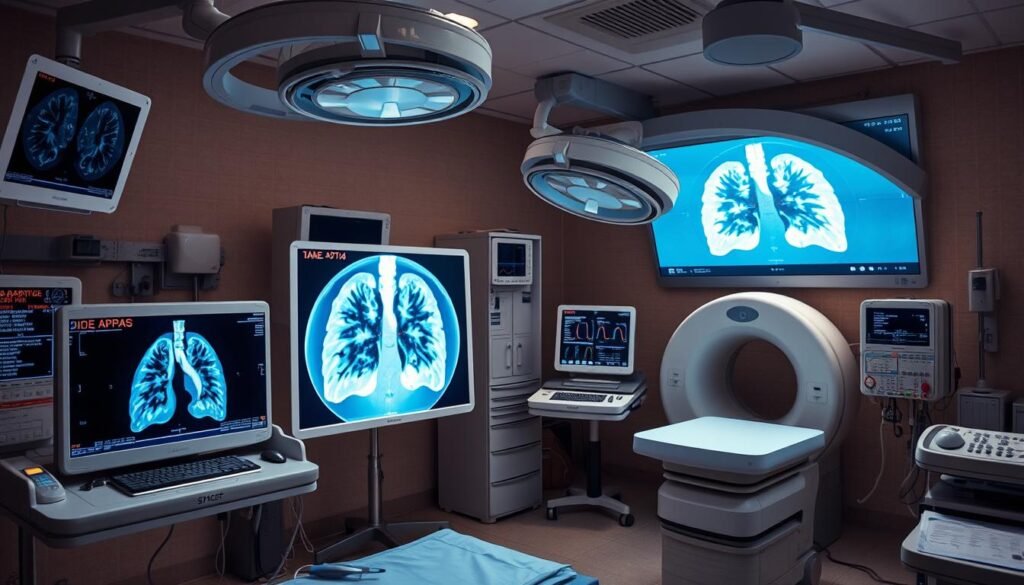Adenocarcinoma lung cancer is very common, accounting for about 40% of all non-small cell lung cancers. In this guide, we’ll cover everything you need to know about stage 4 adenocarcinoma. This stage is serious, as the cancer has spread a lot. It’s key for patients and their families to understand this to grasp the diagnosis, treatment, and emotional hurdles.
This type of lung cancer is seen more in nonsmokers and women. Early detection is crucial because it often shows no clear symptoms at first. This guide will explain stage 4 lung adenocarcinoma’s impact, prognosis, and treatment options. Knowing about this can help patients talk better with doctors and enhance their life quality.
Key Takeaways
- Adenocarcinoma of the lung is a leading type of lung cancer, making up about 40% of cases.
- Advanced lung adenocarcinoma indicates significant disease progression with potential metastasis.
- Recognizing symptoms early is vital for effective management and treatment.
- Understanding the staging process helps clarify treatment options and survival expectations.
- Medical support is crucial in navigating the emotional and practical aspects of advanced lung cancer.
Understanding Stage 4 Lung Cancer
Stage 4 lung cancer is the most severe stage of this disease. This means the cancer has spread from the lungs to other body parts. It can now affect several organs, such as bones and the brain. For patients and their families, knowing about this stage is crucial.
The TNM staging system is used to measure how far lung cancer has progressed. It looks at three main factors:
- T (Tumor): This talks about the tumor’s size and how far it’s spread.
- N (Nodes): This shows if nearby lymph nodes are affected.
- M (Metastasis): This checks if cancer has reached distant areas of the body.
Correct staging is key to making a good treatment plan. This might include chemotherapy, targeted treatments, or immunotherapy. People with metastatic lung cancer face many health issues. Therefore, care plans are tailored to their needs. The main aim is to enhance life quality while controlling the cancer’s growth.
About 85% of lung cancer cases are Non-Small Cell Lung Cancer (NSCLC). Small Cell Lung Cancer (SCLC) makes up roughly 15%. Knowing these numbers helps us understand the treatments for stage 4 lung cancer better.
The Basics of Adenocarcinoma Lung Cancer
Adenocarcinoma lung cancer is the most common kind of non-small cell lung cancer (NSCLC), making up about 40% of all lung cancers. It comes from glandular cells in the lungs that make mucus and usually develops on the lung’s edges. It’s often found in women and usually affects people aged 20 to 46.
Adenocarcinoma is the main type found in non-smokers. Knowing the difference between lung cancer types is crucial because each type needs a different treatment. Understanding how small cell lung cancer is different from non-small cell lung cancer changes the way doctors treat these conditions.
Treatment for lung adenocarcinoma is getting better with new targeted therapies. Now, there are nine FDA-approved treatments for specific gene changes in tumors, like ALK and EGFR. For advanced non-small cell lung cancer, it’s critical to test the tumor to find the best treatment for each patient.
Staging for lung cancer goes from 0 to IV. Stage IV means the cancer has spread to places like the liver or bones. While stage IV lung adenocarcinoma can’t be cured, some treatments can help control symptoms and may slow the cancer.
Symptoms of Stage 4 Adenocarcinoma Lung Cancer
Stage 4 adenocarcinoma lung cancer brings many symptoms that greatly affect the patient’s life. It’s important to know these symptoms early for better handling. They include common signs patients feel and those from cancer spreading to other parts.
Common Symptoms Experienced
Stage 4 adenocarcinoma patients often face several hard symptoms. Key symptoms of lung adenocarcinoma include:
- Persistent cough that gets worse
- Hemoptysis, or coughing up blood
- Chest pain, sharp or dull
- Shortness of breath with little effort
- Fatigue affecting daily life
- Weight loss from not feeling hungry
Knowing these symptoms helps spot health changes early. More info can be found at this resource on lung cancer symptoms.
Symptoms Related to Metastasis
When lung cancer gets worse, it might spread to other organs. This leads to more problems. Symptoms of metastases depend on where it spreads. Some include:
- Headaches from brain spread
- Jaundice from liver impact
- Bone pain or swelling
- Swollen lymph nodes
These signs can differ and may point to needing new treatments. Spotting these early helps adjust care. For treatment insights, check this guide on lung cancer management.
Diagnosis: How Stage 4 Lung Cancer is Identified
Finding stage 4 lung cancer starts with several steps. First, doctors gather your health history and check your body. Then, they use imaging tests to see how far the cancer has spread. These tests include:
- X-rays
- CT scans
- MRIs
- PET scans
These tests help doctors see if the cancer has spread from the lungs. Each imaging method is unique and helps look at the cancer closely.
To confirm stage 4 lung cancer, doctors may need to take a small piece of tissue from your lung, called a biopsy. Checking this tissue helps them know exactly what kind of cancer it is. This step is key to figuring out the best plan for treatment.
Here’s a brief look at different imaging tests and what they do in finding lung cancer:
| Imaging Test | Purpose |
|---|---|
| X-ray | Initial screening tool to detect lung abnormalities |
| CT Scan | Detailed cross-sectional images to identify tumor size and location |
| MRI | Used for assessing brain involvement or spinal metastasis |
| PET Scan | Evaluates metabolic activity and spread of cancer in the body |
People over 50 and those who smoked a lot or quit in the last 15 years should get checked for lung cancer. It’s very important to diagnose stage 4 lung cancer correctly. Knowing the exact type of cancer helps doctors find the best way to treat it.

Adenocarcinoma Lung Cancer Stage 4: What It Means
When someone is told they have adenocarcinoma lung cancer stage 4, it means the cancer has spread. This is a major worry for patients and their loved ones. About 40% of these people find themselves facing tough choices and uncertainty regarding their future.
There are two levels in stage 4 lung cancer: 4A and 4B, with 4B being the more severe. At this point, surgery isn’t usually an option. The goal of treatment shifts to extending life and easing symptoms with methods like chemotherapy and immunotherapy. These treatments focus on the cancer’s unique genetic changes.
The five-year survival rate for stage 4 non-small cell lung cancer is low, at just 4%. The average person may live about eight months after being diagnosed. Yet, new therapies tailored to specific patients have shown promise, letting some live longer with the disease.
Many factors affect how a patient might do, such as their overall health, their cancer’s genetic makeup, and if the cancer has spread. Tests to find these genetic traits can guide treatment choices. Drugs like Rybrevant are available for some conditions. Even so, the late stage of the cancer poses a significant challenge.
Talking about the outlook and end-of-life care is crucial for patients and their families. These conversations can enhance life quality and reduce the sense of being alone in the struggle. Looking into the National Cancer Institute’s clinical trials could offer hope for new treatments. For more on stage 4 lung cancer treatments, visit this link.
| Substage | Description | Prognosis |
|---|---|---|
| 4A | Cancer has spread to nearby lymph nodes or other parts but is less extensive. | Short-term prognosis may vary. |
| 4B | Cancer has spread extensively to other organs or areas, representing the most severe form. | Generally worse prognosis; many patients have a shorter lifespan. |
Treatment Options for Stage 4 Adenocarcinoma Lung Cancer
Treatment for stage 4 adenocarcinoma lung cancer looks at each person’s unique situation. A mix of therapies is often needed to handle symptoms and boost life quality.
Surgery and Radiation Therapy
Surgery can be an option for isolated metastatic tumors. If surgery isn’t possible, radiation therapy can help ease symptoms. It targets cancer in the brain or adrenal glands, for instance. There are also endobronchial therapies. They clear tumor blockages that hinder breathing.
Chemotherapy and Targeted Therapy
Chemotherapy is a go-to when tumor mutations are unknown. It may pair drugs like cisplatin or carboplatin with gemcitabine. This is based on what works best for the patient. If tumors have certain genetic changes, targeted therapy is a great choice. EGFR-positive cancer, for instance, might respond well to erlotinib or osimertinib. Treatments for KRAS or ROS1 mutations include drugs like sotorasib or crizotinib.
Personalized treatment plans benefit from genetic testing. It’s vital to talk about treatment paths, including clinical trials. Stopping smoking after diagnosis also helps. For more, see this guide.

Palliative Care for Advanced Lung Cancer
Palliative care helps patients with advanced lung cancer live better. It’s for everyone, no matter how sick they are. The goal is to ease symptoms and support patients emotionally and practically.
A team of doctors, nurses, social workers, and others provide this care. They create a plan for each patient’s needs. Talking about palliative care early in the cancer journey is crucial. It ensures patients get the support they need.
Advanced lung cancer care covers many symptoms. These may include:
- Pain management
- Stress reduction
- Shortness of breath
- Fatigue
- Nausea
- Anxiety and depression
Care may include treatments to breathe easier, pain relief, and emotional support. It can also involve massage and mindfulness to help patients feel better.
Palliative care can be provided in many places, like hospitals or at home. This makes it easier for patients to get care where they prefer. It’s all about providing the best care for each patient’s needs.
Palliative care teams play a big role in improving patients’ and families’ lives. They do more than manage symptoms. They focus on improving life quality amid the challenges of lung cancer.
Survival Rates and Quality of Life in Stage 4 Lung Cancer
Stage 4 lung cancer is quite serious. Only about 9% survive past five years. The one-year survival rate falls between 15% and 19%.
Survival rates can change based on several factors. Here are the median times people live at different metastatic stages:
| Metastatic Stage | Median Survival (Months) |
|---|---|
| M1a | 11.4 |
| M1b | 11.4 |
| M1c | 6.3 |
Your age and gender might affect your survival chances. People under 50 have a 14.2% chance of surviving five years. For those 65 or older, it drops to 5.6%. Women have a slight edge, with an 8.6% survival rate.
Different types of lung cancer show different survival rates. Lung adenocarcinoma patients have a 20.6% chance of making it five years. Squamous cell carcinoma is at 17.6%, and large cell carcinoma at 13.2%.
But it’s not all about survival rates. Quality of life is also vital. Good symptom management and emotional support matter a lot. Factors like staying active, not smoking before treatment, and participating in care strategies help.
About 75% of people with advanced lung cancer have other chronic diseases. The care plan should address these issues to improve life quality. Palliative care might not extend life, but it does help manage symptoms.

Support and Resources for Patients and Families
Facing stage 4 adenocarcinoma lung cancer can be tough. Both patients and their families may feel overwhelmed. Seeking support for lung cancer patients is very important. There are many resources available to help on this difficult journey.
The American Cancer Society (ACS) offers help any time through their 24/7 cancer helpline at 1-800-227-2345. ACS CARES™ also provides lots of helpful info and personal support for patients and caregivers.
Dealing with cancer often means financial worries. The Hope Lodge® offers lodging grants, working with local health systems. With help from Extended Stay America, they make sure families can stay focused on getting better, not on their bills.
Getting to treatment is another big obstacle. The Road To Recovery program matches patients with volunteer drivers. This ensures patients get to their appointments without any stress.
- The Cancer Survivors Network gives patients and caregivers a place to share and connect online.
- LUNGevity’s Lung Cancer HELPLine offers free, personalized support during the week. They help with any concerns patients have.
- EverYou™ provides wigs and other products. These help people feel like themselves during and after treatment.
It’s a good idea for families to look into community resources, specialist hospitals, and learning workshops. These resources for lung cancer families offer both emotional and practical help.
Giving Docs helps with important planning for the future, offering peace of mind. LUNGevity’s survivorship conferences strive to connect and uplift those touched by lung cancer. They share helpful coping strategies and info on different types of lung cancer.
Accessing resources and going to workshops can greatly improve life quality for patients and their families. For more information, please visit this resource page.
| Resource | Service Offered | Contact/Website |
|---|---|---|
| American Cancer Society | Cancer helpline, community resources | 1-800-227-2345 |
| Hope Lodge® | Lodging grants | Website |
| LUNGevity | Support Line and survivorship conferences | 844-360-5864 |
| Road To Recovery | Transportation assistance | Website |
| Cancer Survivors Network | Online support community | Website |
Conclusion
Know that grasping stage 4 lung cancer’s complexities is key for affected individuals. This guide shows early detection and custom treatments are crucial for better outcomes. Sadly, only 8% survive past five years when the cancer is far spread, highlighting the need for quick action.
Dealing with stage 4 lung cancer is tough. But, there’s hope thanks to new treatments and drugs. People like Sara Whitlock find extended life and improved living through clinical trials. This shows the power of ongoing research in fighting this illness.
Having a strong support network is also vital for those fighting lung cancer. Being close to family, friends, and groups who understand can make a big difference. This article’s summary on stage 4 lung cancer aims to enlighten and guide patients and their loved ones through this tough journey.